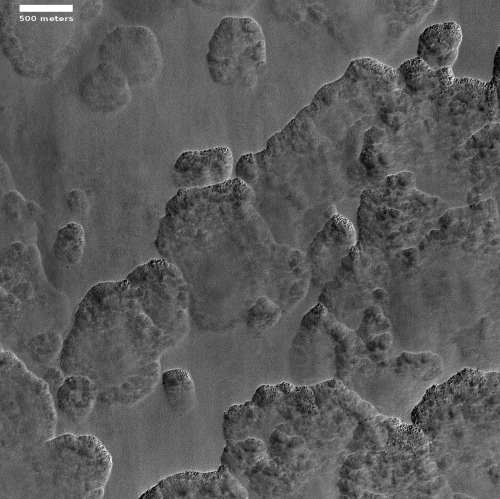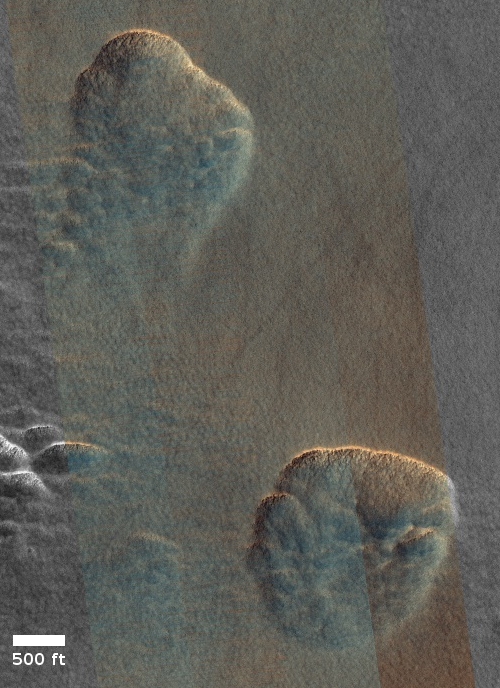Big scallops in the Martian southern latitudes
Cool image time! The photo to the right, rotated, cropped, and reduced to post here, shows an example of some large scalloped depressions in the high southern latitudes of Mars.
Taken by the high resolution camera on Mars Reconnaissance Orbiter (MRO) on June 27, 2020, these scallops resemble in many ways the ice scarps that scientists have previously found at this same latitude, both to the east and west of where these scallops are located. With those scarps, the data suggests that a very pure layer of ice is visible in the cliff face, and that over time the cliff retreats northward due to sublimation of that ice.
The scallops in the photo to the right suggest the same process, though the differences raise questions. As explained by Colin Dundas of the U.S. Geological Survey’s Astrogeology Science Center in Arizona,
The scalloped depressions are likely related, but not exactly the same as the scarps and their pits. The two are likely forming in similar ice-rich materials, and as you mention, the scarps seem to form pits by retreating towards the equator (north in this case).
…There are a lot of variables that control how the surface evolves as ice sublimates: temperature (and thus slope and orientation), the amount of debris cover, how much debris is embedded in the ice, and what causes it to become unstable in the first place. For example, bare ice will sublimate under most conditions in the mid-latitudes, but ice that’s covered by 10 cm of regolith will be stable on many slopes. These variables can interact in complicated ways. We don’t yet fully understand what causes different types of sublimation landform.
To the right is cropped section from another MRO high-res image of different scallops in the same region, taken on July 18, 2020, this time at full resolution and in color. The blue might indicate water, or a rougher surface.
All the variables that Dundas outlines above could explain why we get scallops in the image above and to the right, and scarps (with a steep cliff) at other locations. He also explains, almost as a side note, why many of the glacial features that scientists have detected in MRO images are not sublimating away quickly. All they need for protection is a layer of dust and dirt and sand that is only 10 centimeters or four inches thick.
With the two scallops to the right, the yellowish gold rough terrain at the northernmost point of both scallops is where the sublimation is occurring, and it is here where wind and collapse over time has the most opportunity to wipe that protective layer away, thus allowing the ice below to sublimate away.

Finally, to the right is an overview map of Mars. The white boxes are places where ice scarps have been found. The two black boxes, numbered one and two, are the two images of scallops above. The many very tiny red boxes are all the images that MRO’s high resolution camera has so far taken on Mars.
At first glance this global map might give the impression that much of the planet has been photographed at high resolution. A closer look shows that many regions, including the very area of Mars where these scallops are found, has had little coverage. Much of Mars has only been seen from a distance. Even these high resolution images only have a resolution of about 10 inches per pixel. Small objects are not resolved.
On Christmas Eve 1968 three Americans became the first humans to visit another world. What they did to celebrate was unexpected and profound, and will be remembered throughout all human history. Genesis: the Story of Apollo 8, Robert Zimmerman's classic history of humanity's first journey to another world, tells that story, and it is now available as both an ebook and an audiobook, both with a foreword by Valerie Anders and a new introduction by Robert Zimmerman.
The print edition can be purchased at Amazon or from any other book seller. If you want an autographed copy the price is $60 for the hardback and $45 for the paperback, plus $8 shipping for each. Go here for purchasing details. The ebook is available everywhere for $5.99 (before discount) at amazon, or direct from my ebook publisher, ebookit. If you buy it from ebookit you don't support the big tech companies and the author gets a bigger cut much sooner.
The audiobook is also available at all these vendors, and is also free with a 30-day trial membership to Audible.
"Not simply about one mission, [Genesis] is also the history of America's quest for the moon... Zimmerman has done a masterful job of tying disparate events together into a solid account of one of America's greatest human triumphs."--San Antonio Express-News
Cool image time! The photo to the right, rotated, cropped, and reduced to post here, shows an example of some large scalloped depressions in the high southern latitudes of Mars.
Taken by the high resolution camera on Mars Reconnaissance Orbiter (MRO) on June 27, 2020, these scallops resemble in many ways the ice scarps that scientists have previously found at this same latitude, both to the east and west of where these scallops are located. With those scarps, the data suggests that a very pure layer of ice is visible in the cliff face, and that over time the cliff retreats northward due to sublimation of that ice.
The scallops in the photo to the right suggest the same process, though the differences raise questions. As explained by Colin Dundas of the U.S. Geological Survey’s Astrogeology Science Center in Arizona,
The scalloped depressions are likely related, but not exactly the same as the scarps and their pits. The two are likely forming in similar ice-rich materials, and as you mention, the scarps seem to form pits by retreating towards the equator (north in this case).
…There are a lot of variables that control how the surface evolves as ice sublimates: temperature (and thus slope and orientation), the amount of debris cover, how much debris is embedded in the ice, and what causes it to become unstable in the first place. For example, bare ice will sublimate under most conditions in the mid-latitudes, but ice that’s covered by 10 cm of regolith will be stable on many slopes. These variables can interact in complicated ways. We don’t yet fully understand what causes different types of sublimation landform.
To the right is cropped section from another MRO high-res image of different scallops in the same region, taken on July 18, 2020, this time at full resolution and in color. The blue might indicate water, or a rougher surface.
All the variables that Dundas outlines above could explain why we get scallops in the image above and to the right, and scarps (with a steep cliff) at other locations. He also explains, almost as a side note, why many of the glacial features that scientists have detected in MRO images are not sublimating away quickly. All they need for protection is a layer of dust and dirt and sand that is only 10 centimeters or four inches thick.
With the two scallops to the right, the yellowish gold rough terrain at the northernmost point of both scallops is where the sublimation is occurring, and it is here where wind and collapse over time has the most opportunity to wipe that protective layer away, thus allowing the ice below to sublimate away.

Finally, to the right is an overview map of Mars. The white boxes are places where ice scarps have been found. The two black boxes, numbered one and two, are the two images of scallops above. The many very tiny red boxes are all the images that MRO’s high resolution camera has so far taken on Mars.
At first glance this global map might give the impression that much of the planet has been photographed at high resolution. A closer look shows that many regions, including the very area of Mars where these scallops are found, has had little coverage. Much of Mars has only been seen from a distance. Even these high resolution images only have a resolution of about 10 inches per pixel. Small objects are not resolved.
On Christmas Eve 1968 three Americans became the first humans to visit another world. What they did to celebrate was unexpected and profound, and will be remembered throughout all human history. Genesis: the Story of Apollo 8, Robert Zimmerman's classic history of humanity's first journey to another world, tells that story, and it is now available as both an ebook and an audiobook, both with a foreword by Valerie Anders and a new introduction by Robert Zimmerman.
The print edition can be purchased at Amazon or from any other book seller. If you want an autographed copy the price is $60 for the hardback and $45 for the paperback, plus $8 shipping for each. Go here for purchasing details. The ebook is available everywhere for $5.99 (before discount) at amazon, or direct from my ebook publisher, ebookit. If you buy it from ebookit you don't support the big tech companies and the author gets a bigger cut much sooner.
The audiobook is also available at all these vendors, and is also free with a 30-day trial membership to Audible.
"Not simply about one mission, [Genesis] is also the history of America's quest for the moon... Zimmerman has done a masterful job of tying disparate events together into a solid account of one of America's greatest human triumphs."--San Antonio Express-News



